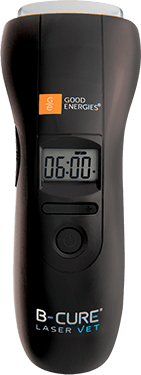Shoulder Arthritis
Laser Therapy for Shoulder Arthritis
Shoulder arthritis (also known as osteoarthritis) occurs when bony abnormalities in the shoulder joint lead to instability, friction, and/or cartilage loss, contributing to pain and inflammation. An underlying orthopedic condition is almost always to blame for the development of shoulder arthritis, but factors such as body weight and genetics also play vital roles.
One of the most common causes of shoulder arthritis in dogs is Osteochondrosis Dissecans (OCD). This condition occurs commonly in young large or giant breed dogs when immature cartilage fails to form bone (usually at the head of the femur—where shoulder articulation occurs). This can lead to a cartilage “flap” that communicates with the joint and may even break off into the joint cavity.
Signs of shoulder arthritis
Depending on the type and severity of a disease, signs of shoulder arthritis may be mild to severe. Owners will commonly observe:
- Limping, especially after exercise
- Changes in gait
- Decreased activity
- Stiffness
- Pain on examination or manipulation of the shoulder
- Decreased appetite or other behavioral changes
Veterinarians may observe more subtle signs of shoulder arthritis upon examination, such as subtle lameness or forelimb muscle atrophy. Pets with minor shoulder arthritis may not exhibit any signs, especially in the early stages.
Diagnosing shoulder arthritis
Identifying shoulder arthritis in dogs is typically a two-step process. Initially, a thorough physical examination is performed, focusing on the musculoskeletal system. The veterinarian will palpate each joint, evaluating for abnormalities in range of motion, grating, or pain. They will also perform a gait assessment to further localize the area of concern. If the shoulder is determined to be the source of dysfunction, further diagnostics may be pursued.
Radiographs (x-rays) can be helpful in identifying OCD, osteophyte (bone spur) formation, and other signs indicative of shoulder disease, although advanced imaging techniques such as arthroscopy, computed tomography (CT), or magnetic resonance imaging (MRI) may be necessary for diagnosis. Other diagnostics such as blood work and urine testing may help rule out causes related to cancer or infection.
Occasionally, light sedation is needed to achieve an accurate diagnosis.
Traditional shoulder arthritis treatments
Some conditions that contribute to shoulder arthritis can—and should—be treated surgically, including severe OCD. For dogs whose conditions don’t necessitate surgery or who may not be good candidates for surgery, medical management can be pursued. In general, a multi-modal pain management approach is ideal for pets suffering from shoulder pain. Possible treatments may include:
- Activity restriction
- Pain medications, including anti-inflammatory drugs or narcotics
- Supplements to encourage cartilage protection
- Physical therapy
- Chiropractic care
- Acupuncture
- Home modifications to minimize jumping or slipping (i.e. ramps, rugs, or steps)
- Maintenance of a lean body weight
Laser therapy for shoulder arthritis
Low-level laser therapy (LLLT) is an emerging treatment modality that utilizes a divergent light beam to address pain, swelling, and inflammation throughout the body. By focusing on affected tissues at a cellular level, these Class IIB medical lasers trigger beneficial physiological activities to promote healing and repair—where and when it is needed the most. This results in:
- Increased production of collagen, enzymes, and Adenosine Triphosphate (ATP, a major energy source)
- Increased protein synthesis and cellular metabolism
- Improved blood flow and lymphatic drainage
The benefits of these therapeutic effects on dogs are plentiful, including a reduction in chronic pain. The best part? LLLT is proven to be safe and effective with no known side effects.
LLLT is a beneficial component of a multi-modal approach to shoulder pain, regardless of the underlying condition. Whether your dog suffers from arthritis or is recovering from OCD surgery, LLLT can provide both pain relief and accelerated wound healing by reducing inflammation and encouraging cell regeneration.
At-home laser treatment
Traditionally, dogs could only reap the benefits of laser therapy by visiting veterinary practices equipped with this then-highly specialized tool. While low-level laser therapy is now widely available to veterinarians, it often requires specific staff training, protective eyewear, and frequent appointments for desired results to be achieved.
The B-Cure Laser Vet is a handheld device that offers all of the benefits of low-light laser therapy for use in the comfort of your own home. With its unique 4.5 cm beam, the B-Cure Laser Vet can safely and effectively provide long-lasting pain relief from skeletal, muscular, and neurological conditions of the shoulder.
User-friendly and cost-effective, the B-Cure Laser Vet is a great ancillary therapy that can be used in conjunction with, or as an alternative to, traditional should arthritis treatments, depending on the severity of the disease it is being used to treat. The B-Cure Laser Vet is safe for use by all family members with no need for protective eyewear.
Shoulder arthritis treatment protocol
Most dogs with shoulder arthritis can adhere to the following protocol, beginning with a dosage of 1.5 minutes in each position, gradually increasing the treatment duration to 4 minutes in each position. The exact placement of the B-Cure Laser Vet will depend on your pet’s condition and area of pain, but a general guideline is as follows:
- Place the device behind the shoulder joint, vertically for 1.5 minutes
- Place the device in front of the shoulder joint, vertically for 1.5 minutes
- Place the device above the shoulder joint, horizontally for 1.5 minutes
- Place the device below the shoulder joint, horizontally for 1.5 minutes
For optimal results, repeat these steps twice daily or as directed by your veterinarian.
Sources:
https://www.acvs.org/small-animal/osteochondrosis-of-the-shoulder
https://www.acvs.org/small-animal/osteoarthritis-in-dogs
https://www.veterinarypracticenews.com/uses-evidence-and-safety-of-laser-therapy/




